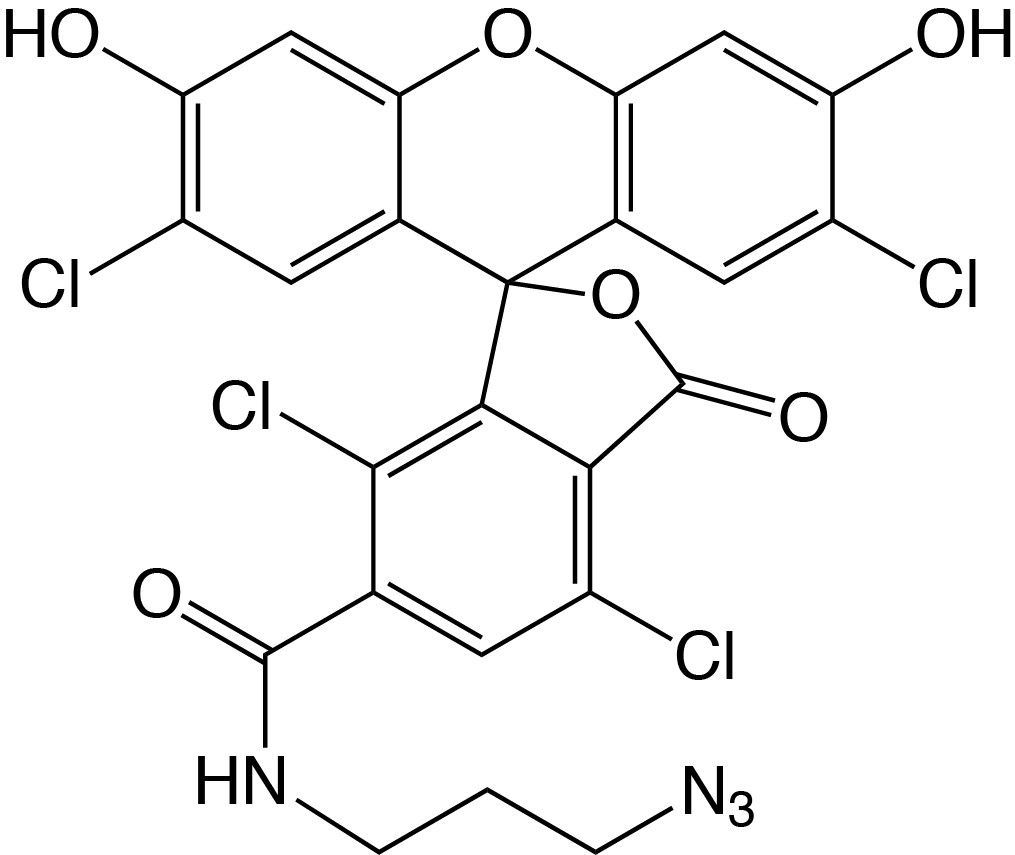6-TET Azide

Catalog Number: 50-2006-xx
Description: 6-TET Azide
| 3-(4,7,2',7'-Tetrachloro-fluoresceinyl-6-carboxamido)-propyl azide |
| Formula: C24H14Cl4N4O6 |
M.W.: 596.20 |
|
Diluent: DMSO |
|
|
| Storage: Freezer storage, -10 to -30°C, dry |
| Stability in Solution: 1-2 days |
COPPER-FREE CLICK CHEMISTRY
At Glen Research, our goal was to offer a copper-free click phosphoramidite reagent with the following properties:
- Simple to use
- Stable in solution on the synthesizer
- Stable to ammonium hydroxide and AMA
- Excellent click performance in 17 hours or less at room temperature
From the variety of cyclooctyne-based copper-free click reagents so far described, we have chosen to offer compounds based on a dibenzo-cyclooctyne (DBCO) structure. We are offering 5’-DBCO-TEG Phosphoramidite for preparing oligos with a 5’-DBCO modification and DBCO-dT-CE Phosphoramidite for inserting a DBCO group at any position within the oligonucleotide. DBCO-sulfo-NHS Ester is also offered for post-synthesis conjugation reactions. DBCO-modified oligos may be conjugated with azides in organic solvents, such as DMSO, or aqeous buffers. Depending on the azide used, the reaction will go to completion in 4-17 hours at room temperature. Simple desalting on a Glen Gel-Pak™ leads to a product with virtually quantitative conjugation efficiency.
CONJUGATION USING CLICK CHEMISTRY (CONT.)
Glen Research is collaborating with baseclick Gmbh to offer a variety of interesting alkyne phosphoramidites. We offer some azide products and are now embarking on an expansion of our azide catalog. Our strategy is to offer first our most popular labels for general interest and, subsequently, we will add azide products that are not compatible with phosphoramidite chemistry.
Biotin is still our most commonly used label and biotinTEG, with its hydrophilic triethylene glycol spacer, is the most popular biotin product. Desthiobiotin is a biotin analogue that is well captured by streptavidin but the captured product can be easily released by applying a biotin solution to the streptavidin beads. 6-FAM is our most popular fluorescein derivative and we offer azides of both 6-FAM and pivaloyl-protected 6-FAM for situations where subsequent reactions require the 6-FAM to be protected. In both 6-FAM products, the hydrophilic TEG spacer is again used. The azides are offered in 25 and 100 µmole packs for convenient oligonucleotide labelling.
7-Hydroxycoumarin, also known as umbelliferone, is a highly fluorescent, pH-sensitive fluorophore that emits in the blue region of the spectrum. However, its fluorescence is strongly quenched if the hydroxyl is alkylated or phosphorylated, making it useful in high-throughput screening for phosphatases and lipases. Interestingly, it was found that the 3-azido derivative is also highly quenched but, upon reaction with an alkyne in the presence of copper to form the triazole, the fluorescence is restored.1 The clicked coumarin emits at a lambda max of 480 nm and absorbs at 358 nm.
HEX and TET are two of our most popular fluorescein-based dyes for labelling oligonucleotides. We are happy to offer 6-HEX and 6-TET Azides for use in click conjugations.
If you cannot find the answer to your problem then please contact us or telephone +44 (0)1954 210 200